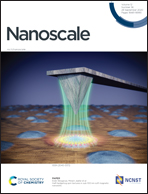Enzyme-responsive chiral self-sorting in amyloid-inspired minimalistic peptide amphiphiles†
Abstract
Self-sorting is a spontaneous phenomenon that ensures the formation of complex yet ordered multicomponent systems and conceptualizes the design of artificial and orthogonally functional compartments. In the present study, we envisage chirality-mediated self-sorting in β-amyloid-inspired minimalistic peptide amphiphile (C10-L/D-VFFAKK)-based nanofibers. The fidelity and stereoselectivity of chiral self-sorting was ascertained by Förster resonance energy transfer (FRET) by the judicious choice of a pyrene (Py)-hydroxy coumarin (HOCou) donor–acceptor pair tethered to the peptide sequences. Seed-promoted elongation of the homochiral peptide amphiphiles investigated by AFM image analyses and Thioflavin-T (ThT) binding study further validated the chiral recognition of the L/D peptide nanofibers. Moreover, direct visualization of the chirality-driven self-sorted nanofibers is reported using super-resolution microscopy that exhibits enantioselective enzymatic degradation for L-peptide fibers. Such enantioselective weakening of the hydrogels may be used for designing stimuli-responsive orthogonal compartments for delivery applications.

- This article is part of the themed collection: 2020 Nanoscale HOT Article Collection


 Please wait while we load your content...
Please wait while we load your content...